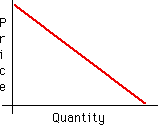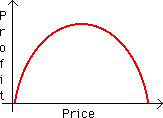Because a monopoly has no compatition, it can raise it's prices infinitely. However, the price can be limited by supply. If the supply of a product is large, then, in order to sell all of it, the monoploy has to lower it's price, as shown to the right.

a monopoly must lower it's price.
The more it want's to sell, the lower
it's price has to be.
